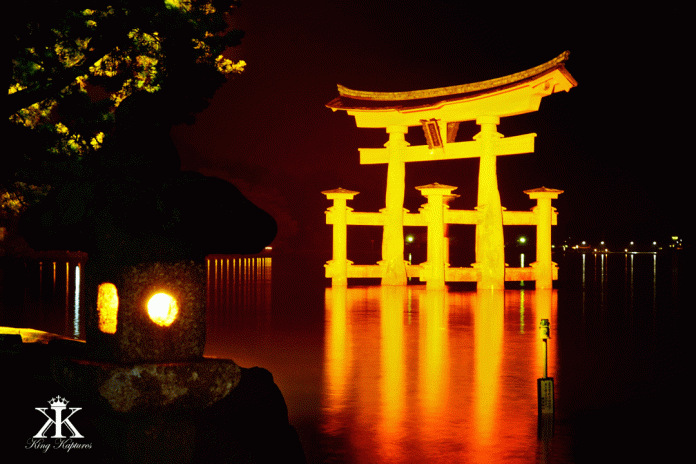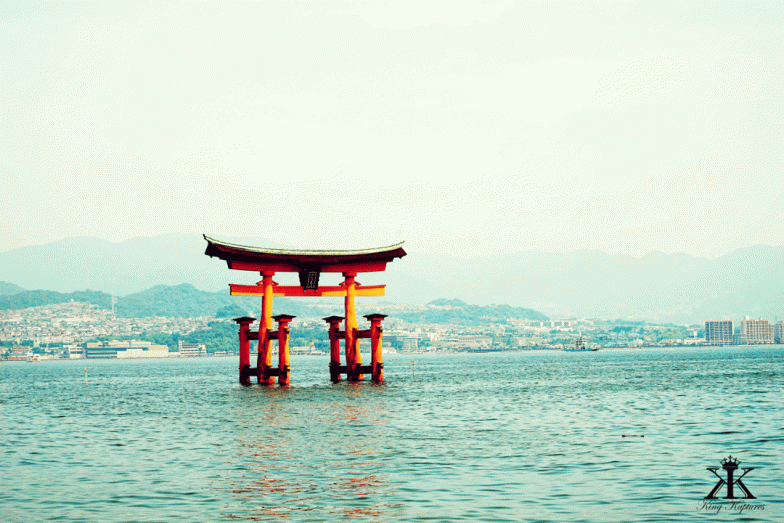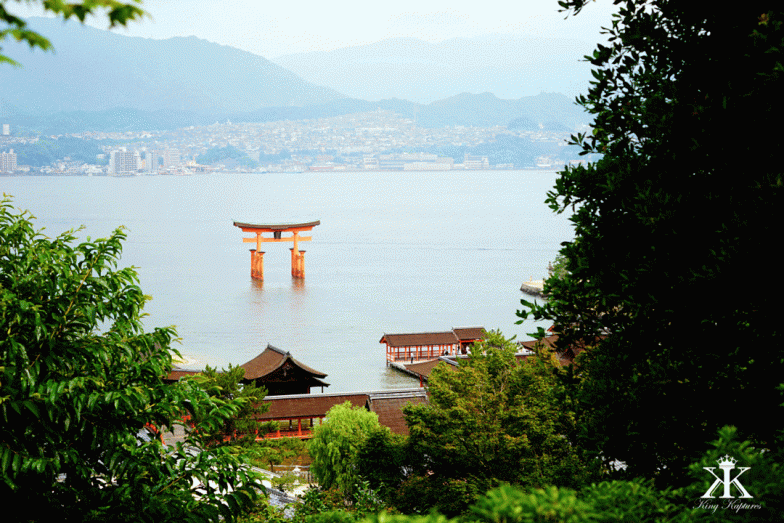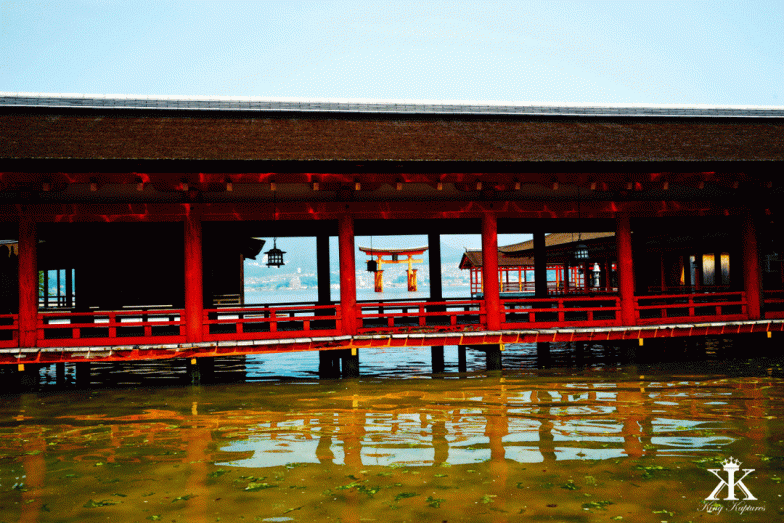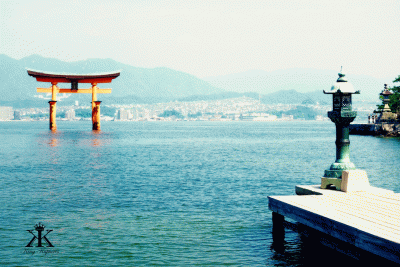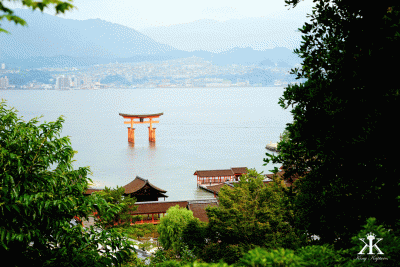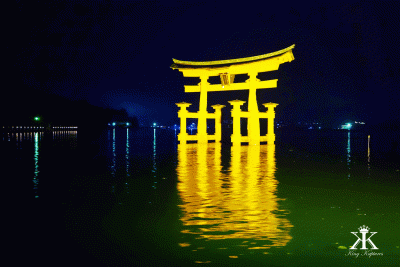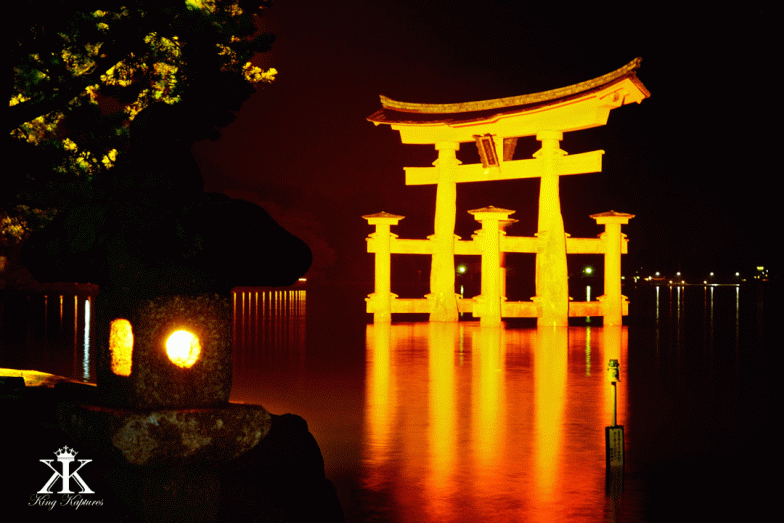CONTRIBUTED BY KEVIN “ELVIS” KING
Standing at the base of perhaps the most iconic torii in all of Asia, it’s easy to feel the divine dimension which seems to emanate from each and every wooden fiber. The Great “Floating” Torii (Otorii) of Itsukushima, a Shinto Shrine on the island of Miyajima, like all torii, marks the boundary of sacred ground– a physical reminder of the split between the spirit and the human worlds. It also remains as the ceremonial shrine entrance for souls of the departed and the living alike.
As one of Japan’s most popular tourist attractions, it is no doubt one of the most recognizable and celebrated features of Japan, and has been officially designated as one of the three most scenic views in all of Japan. It is not to be missed.
The Otorii is located on Miyajima Island, a long-time sacred island just outside of Hiroshima. Combining visits to both the city and the island, my wife and I flew into Hiroshima airport via convenient direct flights to and from Okinawa. The airport, however, is nowhere near either destination, but an efficient and timely Japanese bus service will get you to the central Hiroshima central train station in about 40 minutes. Local train service from there drops you directly at the ferry terminal for Miyajima Island. After a 10 minute scenic boat ride, our hotel picked us up in Miyajima with their shuttle bus service. We easily accomplished this journey with luggage in tow! As an alternative, day trips from Hiroshima are easy and inexpensive via direct ferry service operating between Miyajima Island and Hiroshima’s Peace Memorial Park.
The first Otorii at this location was erected in 1168, a little more than 200 meters offshore. Since then, the gate has continually served the larger Itsukushima Shrine, although the one we see today dates back to a reconstruction in 1875. It is the eighth Otorii in the shrine’s long history. Eight rebuilds is not too shabby for 950 years of sitting in the ocean exposed to the elements!
Arguably, the best time to view the Otorii is during high tide, although one must consider lighting as well. When the waters are high, the gate can appear to float dramatically on or over the sea. At dusk, the arch is often beautifully contrasted against the golden skies of the setting sun and distant mountain ranges.
At these times the Otorii is only accessible by boat. Cruises around the arched gate can be hired at the Miyajima ferry terminal at night when the gate is illuminated by powerful lights along the shore. And, if you’re lucky enough to catch a ride at high tide, the boat will even pass under and through the gate!
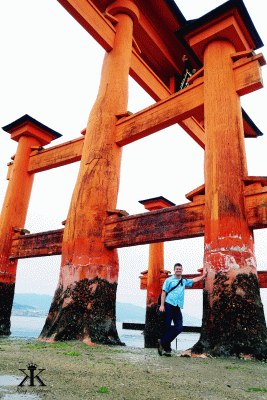 During low tide, the waters recede enough to make a relatively dry trek to the Otorii’s base. At these low water times, numerous ramps and stairs provide easy access from shore into the tidal flats. Plan ahead and bring the appropriate footwear! While the pictures may not be as beautiful, seeing the gate up close and personal is something to behold. The structure is truly a massive one!
During low tide, the waters recede enough to make a relatively dry trek to the Otorii’s base. At these low water times, numerous ramps and stairs provide easy access from shore into the tidal flats. Plan ahead and bring the appropriate footwear! While the pictures may not be as beautiful, seeing the gate up close and personal is something to behold. The structure is truly a massive one!
The Otorii is about 55 feet in height, about 80 feet in length at the arch, and weighs a whopping 60 tons. The main pillars are natural camphor, approximately 500 to 600 years old, a tree type known to be resistant to rot and insects. The smaller supporting pillars are natural cedar. The arch has a roof made of cypress bark thatching. Architecturally, today’s design dates back to 1547, and consists of four smaller torii which support the larger in the style of medieval Ryōbu Shintō (“dual Shinto”), a physical representation of the mixing of esoteric Buddhist and Shinto religions.
The structure itself is not sunk or otherwise secured below the seabed, but stands in place strictly under its own substantial weight. As an engineer, I found this design rather intriguing…if not unlikely. But if you think back 950 years, the technology and tools necessary to build an under-ocean foundation just didn’t exist. Rather, the architect’s strategy focuses on weight, pressure, and wooden joints. Although the pillars themselves are the bases of truly massive trees, another seven tons of weight is added topside by filling the boxed structure below the upper arch with a slew of fist-sized stones that ensure the upper structure stays firmly in place. Then the entire structure is held together by wooden wedges, which absorb motion without unbalancing or otherwise damaging the Torii. The Great Torii seems all but impervious to the best that Mother Nature can throw at it: it has survived, with little or no damage, storms, typhoons, and even earthquakes.
The vermilion color of Shinto Shrines and torii across Japan is believed to help ward off malevolent specters. The lacquer which carries the color also offers some protection from rot and decay, since most torii remain constructed of wood. This is also what provides the brilliantly bright colors that make pictures so theatrical. The sun and the moon are painted on the east and the west (respectively) of the Otorii roof, as implored by Feng Shui in an effort to help further block demons.
Although the Great Torii may be the most memorable part of a visit to Miyajima, there is plenty more to do on this scenic island. Kids will love the wild deer that roam about the city and surrounding nature walks, almost as much as they will “dig” exploring the tidal flats around the Torii at low tide. The Miyajima Aquarium, although small, is a new, clean and well-appointed aquatic attraction well worth a family visit. Mount Misen offers hikers day trips up and down scenic hiking trails, with unparalleled views achieved at the summit, also served by cable car. The island offers a wide variety of traditional Japanese Inns (ryokan) that can suit most anyone’s budget, famed Hiroshima oysters prepared to please most any palate, and quaint pedestrian street markets for that perfect keepsake of your trip.
For more information on the Otorii and Miyajima Island, please see:
https://visit-miyajima-japan.com/en/culture-and-heritage/spiritual-heritage-temples-shrines/le-torii-flottant.html


